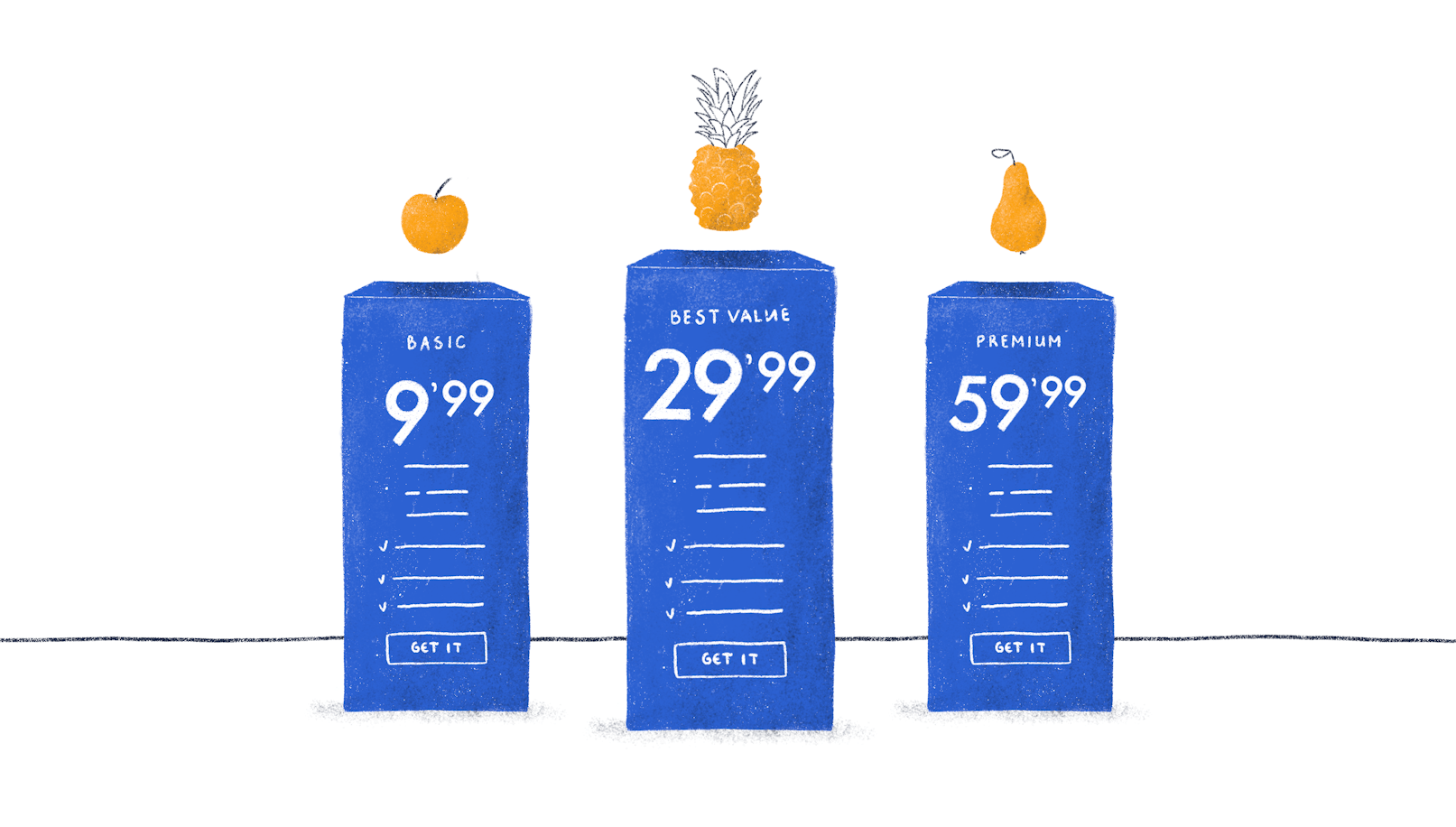There’s no getting around it. Pricing is the single most important tool your business has. As Katherine Paine, Chief Marketing Officer of News Group once noted:
“The moment you make a mistake in pricing, you’re eating into your reputation or your profits”.
And she wasn’t wrong. Research indicates that a 1% improvement in pricing can increase profits by as much as 11%. This shows that while finding the right pricing model isn’t easy, it’s certainly worth it. SaaS pricing models can be particularly tricky to get right. However, striking the right balance between value and revenue can make or break your business.
In this article, we explore everything your company needs to know about SaaS pricing models. We touch on the common types of pricing models and how to choose the right pricing strategy to grow your SaaS business.
What’s a pricing model?
Did you know that most companies spend just 6 hours defining their pricing strategy? And I’m not talking 6 hours a year. That’s 6 hours in a lifetime. If you think about it, that’s like running a marathon on an empty stomach. You simply don’t have the fuel you need to cross the finish line in the first place.
Put simply, your pricing strategy holds the keys to the kingdom. So invest time in researching SaaS pricing models and nailing down the right one. Now let’s take a closer look at what a pricing model is.
A software-as-a-service (SaaS) pricing model is a subscription-based pricing model. As such, customers pay to use a service or product. This is most commonly a yearly or monthly fee.
The nature of SaaS products makes price-setting more complicated. For instance, say your SaaS product comes with different product packages. You must come up with a logical pricing strategy for each package. That takes time, planning, and patience.
That’s not all. The SaaS industry is growing fast. With SaaS trends changing in the blink of an eye, your business needs to review its pricing model regularly to keep up.
Defining SaaS pricing models is sort of like walking a tightrope. It’s all about balance. Plus, one wrong move and it can all come crashing down around you. When it comes to pricing strategy, the goal is to strike the perfect balance between value and profit.
Charge too much and your customers will run a mile. Charge too little and growth will grind to a halt. The simple fact is that pricing strategy, especially in the world of SaaS, is not something your business should neglect.
Types of pricing models
Fed up with the lack of freedom a freemium pricing model offers? Perhaps a flat-rate model is leaving sales a little, well, flat? If you think your current pricing model isn’t working hard enough, it might be time to switch things up. After all, let’s face it. The whole point of a pricing model is to grow your business.
To help you on your quest to optimize the success of your SaaS product, I’ve done some digging. I’m comparing 5 of the major SaaS pricing models to give you the good, the bad, and the ugly of each one.
1. Flat Rate pricing
Let’s start with the most simple option. A flat rate SaaS pricing model offers full access to the product and all its features for one fixed price. This means that every customer pays the same and has the same level of access to the tool.
A flat price is an attractive option for customers because there are no hidden costs or extra monthly fees. The downside is that the plan isn’t personalized. As a result, some users may not unlock the product’s full potential. For instance, half of your customers might never touch the advanced features your products offers while the other half leverage them every day.
This is actually more of an issue than you may think. Let me explain. Customers who aren’t making use of the full range of features could get the impression they are wasting their money. Therefore, their perception of the product value actually decreases by having too much access.
Generally speaking, a flat-rate pricing method works well if your business is targeting individual users or small businesses as opposed to large enterprises.
Here’s a look at the pros and cons associated with a flat-rate pricing model.
Pros & Cons
✅ It’s the most straightforward pricing model to explain to customers.
❌ It’s difficult to maximize profits if all users are treated equally. Your business may miss out on potential revenue.
✅ Its simplicity makes it the easiest to sell. The user pays a one-off fee and they’re ready to go.
❌ Hit or miss in terms of securing users
IXACT Contact is a good example of flat-rate pricing in action.
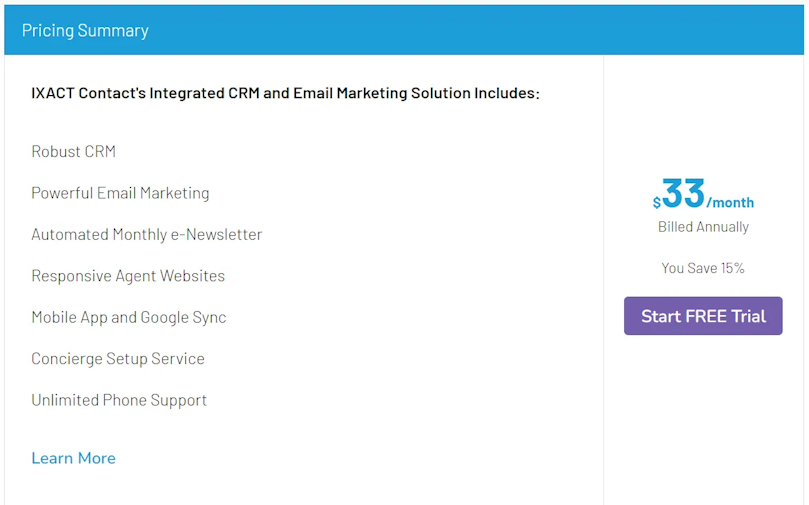
2. Usage-Based pricing
The clue is in the name. Essentially, the idea is that the more you use, the more you pay. It’s a similar concept to a data plan for your cellphone. Let’s say you pay for 4GB of data each month, you’ll be charged a fee for going over your agreed data usage.
Usage-based pricing has its advantages. Namely, the advertised price will always be less than what the user will actually pay each month. Essentially, customers are drawn in by the lure of a low price point. This is particularly effective in attracting individuals or small businesses who will be offered a lower price than large companies. In turn, making them feel like they got a good deal.
See the pros and cons of usage-based pricing models below.
Pros & Cons
✅ Since prices scale with usage, it’s a simple model to understand. There’s no need for overcomplicated pricing tiers
❌ The value is in the usage, not the product. Users may look elsewhere when they reach their usage threshold or incur higher costs
✅ A ‘low risk’ investment. Users know they will only be charged for what they use
❌ Unpredictable revenue
One example of usage-based SaaS pricing is found in AWS. Users only pay for the computing time/power and have access to everything regardless of their tier.
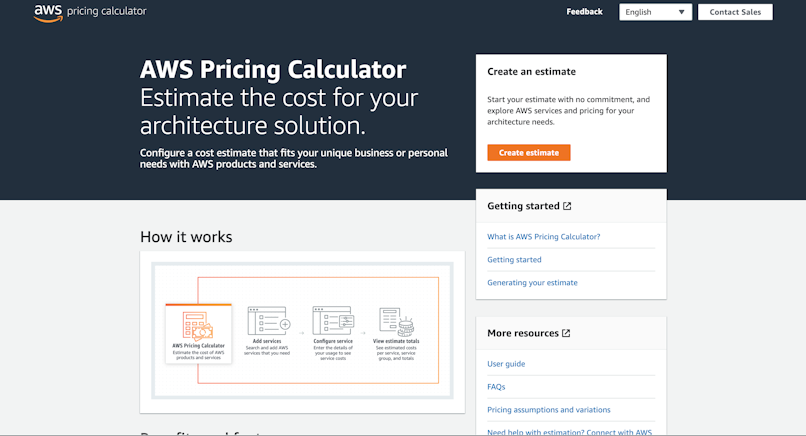
Example: AWS | Source
3. Tier-based pricing
Tier-based pricing is the SaaS pricing model of choice for most businesses. Here’s how it works. Tiered pricing offers multiple package options for different users. Each option, or tier, has its own price and range of features included.
The best part about a tier-based approach is that the tiers can be tailored to suit specific buyer personas. That’s a major selling point. Customers want bespoke options that are customized to their individual needs. Think of it this way. A large enterprise is most likely going to use a product in a very different way than a two-person team. Tiered pricing options allow for different users to build a package that contains only the features they need.
We’ve listed the pros and cons of tier-based pricing below.
Pros & Cons
✅ Persona versatility. Tiers can be customized for different markets and user personas.
❌ Too many package options can get confusing and convoluted
✅ Upsell potential. There are plenty of options for package add-ons and upgrades.
❌ Top-tier users have no option to extend their package
Here’s a tiered pricing example from Hubspot.
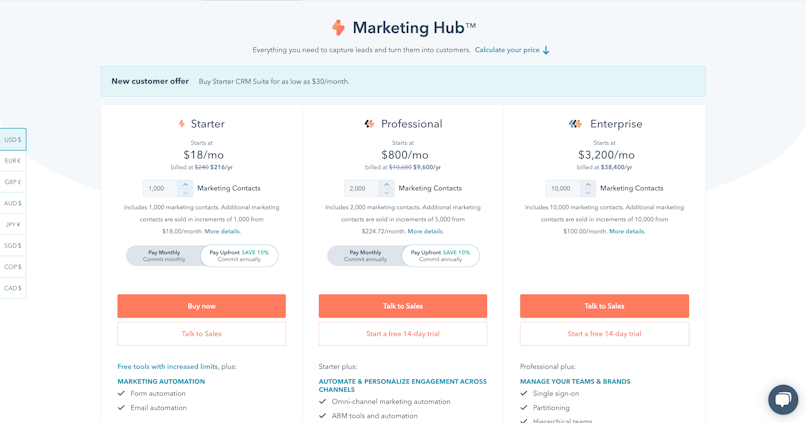
Example: Hubspot | Source
4. Pay-per-seat pricing
Pay-per-seat pricing is another one of the most popular SaaS pricing models. Used by a large number of SaaS companies, it works by charging customers based on the number of users they have on their accounts.
With this model, customers pay based on the number of ‘seats’ rather than usage. For instance, $7 for a single account or $60 for ten users.
The beauty of this pricing model is its simplicity. Customers know exactly how much they have to pay each month, leaving no nasty surprises. The downside is that it may not appeal to rapidly-growing businesses. Put simply, companies who are scaling fast may prefer a pricing plan that won’t charge them more as they grow.
The good news is that there are ways around this. For instance, a pay-per-seat pricing plan that only charges for active users. Here’s an example. Let’s say you get a new client with 500 employees. Even if all 500 employees sign up for your service, the client will only pay for the employees who actually use the service.
Many SaaS companies combine a pay-per-seat pricing model with a tiered-based approach. This offers customers a fully customized pricing option based on their needs.
Below we break down the advantages and disadvantages of pay-per-seat pricing models.
Pros & Cons
✅ Higher adoption automatically means higher revenue
❌ More user accounts equals higher costs. This incentivizes users to find ways around paying more, such as sharing log-ins and being sparing with who they invite
✅ Easy to forecast revenue
❌ At a certain threshold, it may be cheaper to use other tools, making it less attractive to fast-growing businesses
✅ Simple for all parties. Customers can easily calculate how much they need to pay.
❌ Value is measured by the number of users, not the actual value of your product provide
This pricing model revolves around teams. Slack, for instance, is essential for team communication. As such, they charge per seat. Here is an example of pay-per-seat pricing from Slack.
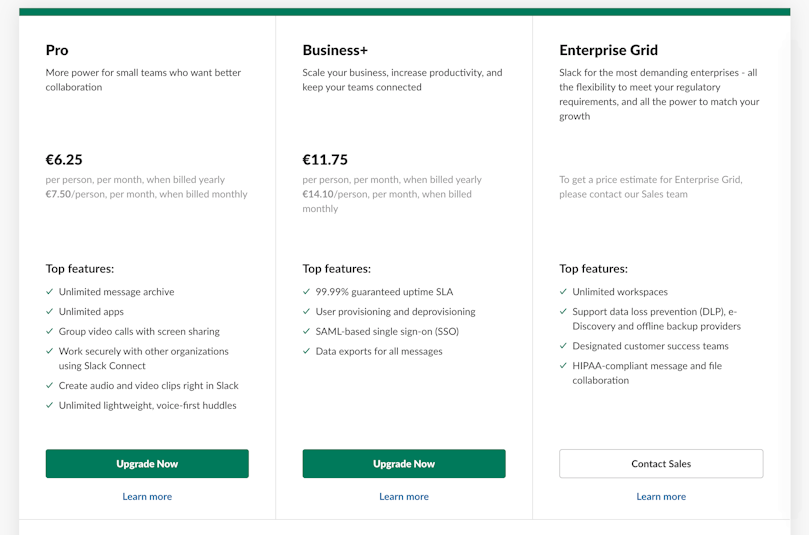
Example: Slack | Source
5. Freemium pricing
The word “freemium” combines the words “free” and “premium”. Pretty clever, huh? Well, it’s not just the name that’s clever. There are actually a lot of benefits of offering a freemium pricing option.
As the name suggests, a freemium pricing strategy offers customers a basic or limited version of a product or service completely free. You may be wondering why on earth SaaS companies would give their products away for free. Let me explain.
Freemium pricing options are a way to break down the barrier to entry. Companies will typically charge a premium or supplementary fee for access to the full range of features the product offers. This pricing strategy combines well with most pricing models.
While freemium pricing plans aren’t for every SaaS business, an increasing number of companies are jumping on board. Here’s why. By offering Freemium SaaS products, businesses can leverage targeted ad space and in-app purchases to increase earnings.
Let’s take a closer look at the positives and negatives associated with freemium pricing models.
Pros & Cons
✅ Removes entry barriers. You can show the value of your product without the risk
❌ Users may not perceive the value of your product because it is free
✅ Builds brand awareness without the need for expensive marketing campaigns
❌ High operational costs. You need to actively upsell to generate revenue. A huge volume is needed for ROI
✅ Potential for multiple revenue streams from ads and in-app purchases to supplement revenue
❌ Lower conversion rates. This can affect the pricing models for premium versions
Grammarly is a great example of how a freemium pricing model should look.
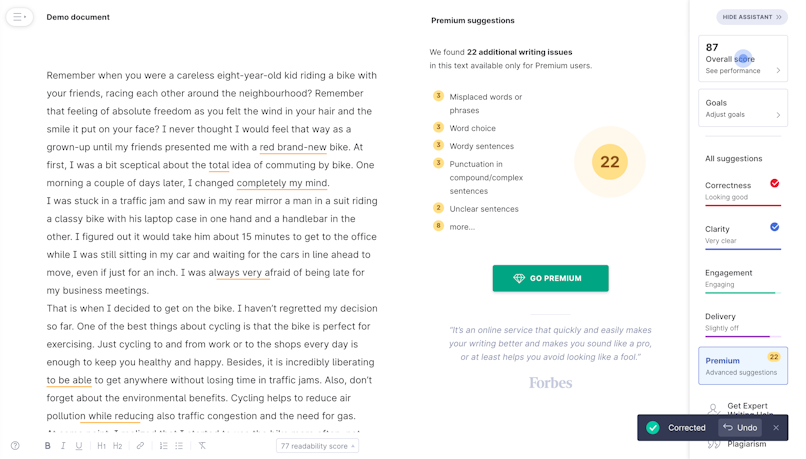
Example: Grammarly
How to choose a pricing model
We’re not going to sugarcoat things, choosing a pricing model for your business isn’t a walk in the park. At the end of the day, your pricing strategy needs to drive cash flow. So, your pricing model needs to weigh up production costs, running costs, critical costs, competitor pricing models, and of course, the value of your product or service. That’s a lot of balls to juggle.
The good news is that if you’re reading this you’re already on the right track. With so much to think about, research is essential.
Read on to discover 5 key factors to consider when picking the right SaaS pricing model for your business.
1. Value
Valued-based pricing is based on how much a business believes customers will pay for a product or service. What does this mean? In a nutshell, it means that businesses don’t set prices based on common factors such as production costs or competitors’ pricing. Instead, they set their prices based on what they think their service or product is worth to the customer.
Picture this. There are two coffee shops on your way to the office. One place charges $1.50 for a decent cup of coffee and the other charges $3. Rather than go to the cheaper place, you religiously choose to get your morning coffee from the more expensive place. Why is that?
Essentially, it’s because you think the coffee from the more expensive coffee shop is worth the extra money. You would rather pay double for a better-quality coffee and a better overall experience. So, in your eyes, that coffee is worth $3.
Value-based pricing is a popular choice in competitive markets such as SaaS. Here’s why.
SaaS tools help users save time and time is a valuable commodity. Let’s say you calculate that your product saves the user around 10 hours per month. If we estimate that an hour of your average user’s time is worth $50, your SaaS product saves customers about $500 per month. Just like the three-dollar coffee, you have now figured out the value of your product for users.
2. Competition
The SaaS industry is a highly competitive market. With so many hats in the ring, it just makes good sense to keep an eye on what your competitors are doing. Especially when it comes to pricing models. There are a couple of ways that businesses can leverage their competitors to grow their business.
Let’s start with penetration pricing. The goal of penetration pricing is to lure customers to try your product by offering low initial prices. For instance, a bank may offer new customers 0% interest on credit cards for the first year. Another example could be a subscription-based SaaS product offering the first month free.
The hope is that the new customers stay after the initial reduced pricing goes up. What’s more, SaaS companies use this strategy to break into the market and entice customers from their competitors. The risk is that the customers will jump ship once the initial reduced-price period runs out.
That’s not the only advantage of analyzing your competitors’ pricing model. It also serves to benchmark your product. In doing so, you may notice that your competitors charge significantly more than you. This could be an indicator that it’s time to increase your prices too.
3. Sustainability
Your pricing needs to be sustainable. It may seem obvious, but you’d be surprised how many businesses don’t have a sustainable pricing model. Let’s face it, running a business costs money. Between employee salaries, production costs, and marketing budgets, your pricing needs to cover these costs and more.
Put simply, SaaS pricing models should generate enough revenue to cover all business expenses and have enough left over to grow the company.
4. Scalability
Speaking of growth, is your pricing model scalable? This is a key factor to consider. Let me paint you a picture.
Your SaaS business is taking off. You have a huge volume of users subscribed to your Freemium product. What’s more, brand awareness is growing and your product is adding value to the lives of your users. Life is good.
Except, your quarterly numbers are telling a different story. You begin to realize that despite all the new attention your business is getting, you are actually spending a large portion of your revenue maintaining your users and trying to upsell them. So, even though your business is gaining traction, it is unable to scale.
It comes down to this. The rate your SaaS business generates revenue should grow at a higher exponential rate than your expenses to maintain your users. If that’s not happening, you may need to reconsider your pricing model.
5. Unique product features
Defining a pricing model without considering the product features is like clothes shopping blindfolded. Chances are, it’s not going to be the right fit.
Here’s an example. Imagine your target audience is solopreneurs. It doesn’t make much sense to charge per seat. On the other hand, if your target audience is large enterprises, then a pay-per-seat pricing plan makes a lot of sense.
Similarly, if your SaaS product has relatively few features, dividing it into tiers probably isn’t the most logical pricing strategy. You may want to opt for a flat rate instead. You get the idea.
Your business will often give you clues about which pricing model will work best. It’s just a case of paying attention and knowing exactly what your product is and who it’s for.
Conclusion
Here’s the thing. There is no easy formula when it comes to defining a pricing strategy for your business. Nor should there be. Every business is different. As we have seen, pricing holds the keys to boosting the bottom line. So, it’s time that SaaS companies start treating it as such.
Your pricing strategy should be a living, breathing thing. Review it constantly, using customer data to drive your decisions. When it comes to SaaS pricing models, research is your best friend. Understanding the different models out there will empower your firm to nail down the best option for the business. Remember, walking a tightrope requires focus and balance. And so does implementing the right SaaS pricing model.

